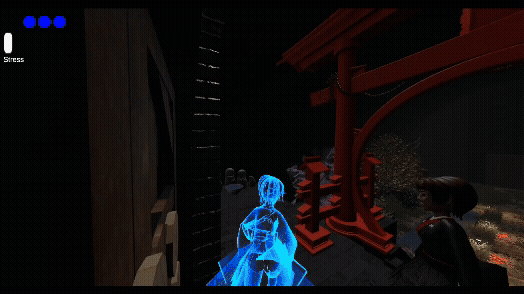Jizo No Akumu
- aka1819
- Feb 20, 2024
- 3 min read
Updated: Sep 15
Jizo no Akumu | USC Thesis Project | Role: Creative Director, Product Owner, Level Designer | Engine: Unreal Engine | Team Size: 30 | Genre: Psychological Horror
Jizo no Akumu is a Japanese psychological horror game where you play as Jizo, a young woman who must use her astral projection abilities to explore a nightmarish world, uncover her family's dark secrets, and evade a demonic entity after her grandmother's funeral.
Obstacles:
My biggest challenges were leading a large team and designing an immersive atmospheric game. Managing 30 students with conflicting schedules and being able to keep up morale and the timeline. From a design perspective, we needed a core mechanic that was deeply intertwined in the game's overall themes and puzzles that guided players without any hand-holding, ensuring they felt immersed and not frustrated while playing and getting lost.

How was this resolved?
As the Creative Director and Product Owner, my role was to be the bridge between creative vision and practical execution, from high-level planning to hands-on level design.
Leading a large and diverse team:
I established a structured production flow to create clarity. This included weekly syncs for all leads and tailored check-ins for smaller teams. I learned to delegate tasks based on individual strengths, which kept the team motivated and productive despite our hectic schedules. To prevent micromanaging, it was about empowering everyone to do their best work

A screenshot of the art team communication channel on discord showing a positive check-in conversation
Designing the core Astral Projection Mechanic:
I thought of and prototyped the mechanic that defines the game. Astral projection allows players to leave their body vulnerable behind and phase through special walls, doors, or areas in the dream world to find hidden clues or unlock the mystery. This created tension due to the player's body being vulnerable and still being able to get attacked and was key to solving environmental puzzles and finding environmental puzzles and messages hidden within or throughout the game.

Puzzle and Level Design
I designed key puzzles like the shrine door puzzle, where players find a hidden animal sequence by projecting through the wall and finding the answer through a puzzle painting. However, through constant iteration, early playtesters got lost.
Solution: Instead of using UI markers, I used subtle environmental storytelling. I added strategic lighting to draw the eye and collaborated with sound designers to use sound cues to hint at secrets and worked with other designers to redesign confusing areas within the game for better game flow. This made it possible for players to experience the game as rewarding rather than perplexing.
Conclusion:
We successfully created a cohesive and atmospheric 15-minute horror demo on schedule. The team remained aligned and passionate throughout development. The final game was praised for its unique and tense mechanics and well-designed levels that built fear without frustration. Leading this project from concept to delivery was the most challenging and rewarding experience and proved my ability to own a creative vision while encouraging a large team to collaborate and create a horror game.

3D Models
3D Models used in the game demo





















Comments